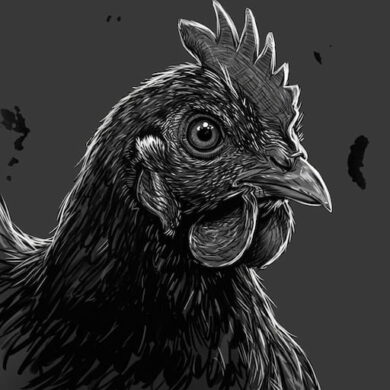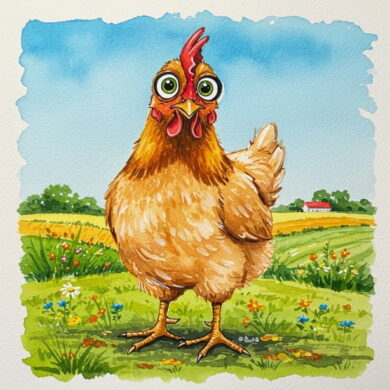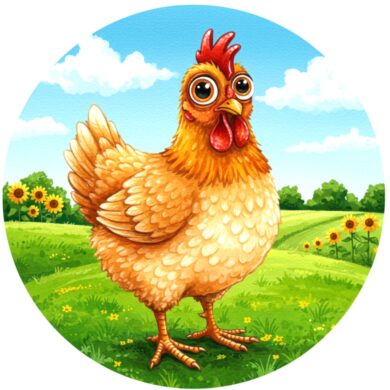Chicken Eyesight Secrets : What These Birds Can See That You Can't
Chicken eyesight capabilities far exceed human vision in several remarkable ways. These birds can see ultraviolet light that remains completely invisible to the human eye, thanks to their tetrachromatic vision system with four types of color cones instead of our three. Compared to humans who process only 25-30 images per second, chickens can register an impressive 150-200 images per second.
The physical structure behind chicken vision is equally fascinating. Their eyes make up approximately 10% of their head mass, while human eyes account for merely 1%. This size difference, combined with a 300-degree field of vision, allows chickens to observe their surroundings with minimal head movement. Additionally, chickens possess a unique double-cone structure that enhances motion detection—a crucial survival adaptation for spotting predators. Perhaps most surprisingly, these birds can recognize up to 100 different faces and even differentiate between positive and negative encounters with both humans and other chickens.

How chicken vision is different from ours
Unlike mammals who lost color vision genes during their nocturnal phase of evolution, chickens never experienced this evolutionary bottleneck. Consequently, these birds developed visual capabilities that far surpass human sight in multiple fascinating ways.
Chickens are tetrachromatic
The fundamental difference between human and chicken vision lies in the number of color receptors. Humans possess three types of cone cells (trichromatic vision) that detect red, green, and blue wavelengths [1]. In contrast, chickens have four types of cone photoreceptors (tetrachromatic vision), allowing them to see red, green, blue, and violet/ultraviolet light [2].
This additional cone dramatically expands their color perception. Chicken retinas contain four single-cone types sensitive to specific wavelength peaks (415, 455, 508, and 571 nm) [3], creating a much richer visual experience than humans can comprehend. Furthermore, the organization of these cones is remarkable—different types are evenly distributed throughout the retina, yet no two cones of the same type are located adjacent to each other [4]. This arrangement represents "the ideal way to uniformly sample the color space of your field of vision" [5].

They can see ultraviolet light
Perhaps most impressively, chickens can perceive ultraviolet light that remains completely invisible to humans. Their visual perception extends to radiation between 320 and 400 nm in the UVA spectrum [6]. This ability offers significant advantages in their daily lives.
The UV sensitivity serves practical purposes: insects, seeds, berries, and fruits reflect UV light, whereas soil and grass do not [7]. This contrast makes food items appear to "glow" against the background, making foraging more efficient. Notably, mother hens can identify healthy chicks through their ultraviolet "glow," allowing them to distinguish which offspring might be ailing [2].
Beyond foraging, UV vision likely aids in navigation. As research shows, chickens can potentially look at the sky's UV gradient to determine which way is north—similar to how humans might read a grayscale drawing to determine which side is closer to white [8].
They can see ultraviolet light
Perhaps most impressively, chickens can perceive ultraviolet light that remains completely invisible to humans. Their visual perception extends to radiation between 320 and 400 nm in the UVA spectrum [6]. This ability offers significant advantages in their daily lives.
The UV sensitivity serves practical purposes: insects, seeds, berries, and fruits reflect UV light, whereas soil and grass do not [7]. This contrast makes food items appear to "glow" against the background, making foraging more efficient. Notably, mother hens can identify healthy chicks through their ultraviolet "glow," allowing them to distinguish which offspring might be ailing [2].
Beyond foraging, UV vision likely aids in navigation. As research shows, chickens can potentially look at the sky's UV gradient to determine which way is north—similar to how humans might read a grayscale drawing to determine which side is closer to white [8].

References
[1] - https://www.dummies.com/article/home-auto-hobbies/hobby-farming/chickens/the-outside-of-the-chicken-eyes-ears-skin-and-feathers-167924/
[2] - https://lafeber.com/backyard-chickens/chickens-see-differently-than-humans/?srsltid=AfmBOopH_HjpDofW6gtSOaaBWXm_e7fOBUhIhJ1P15yyhxqcHvqUYTr2
[3] - https://www.poultry-welfare-extension.com/uploads/2/5/6/3/25631086/pec_chicken_vision_vol10final.pdf
[4] - https://www.livescience.com/8099-chickens-color-humans.html
[5] - https://www.ophthalmologyweb.com/1315-News/33010-Chickens-one-Up-Humans-In-Ability-To-See-Color/?catid=5249
[6] - https://chooks.co.nz/blogs/news/what-can-your-chickens-see-chicken-vision?srsltid=AfmBOooanDocWOYAJpQ-NKI99OkgPXye9ZaVtUtiKrNXGtptx9FNmhnA
[7] - https://www.clorofil.org/post/2023-09-the-fabulous-vision-of-chickens
[8] - https://mikethechickenvet.wordpress.com/2012/03/30/chicken-vision/


